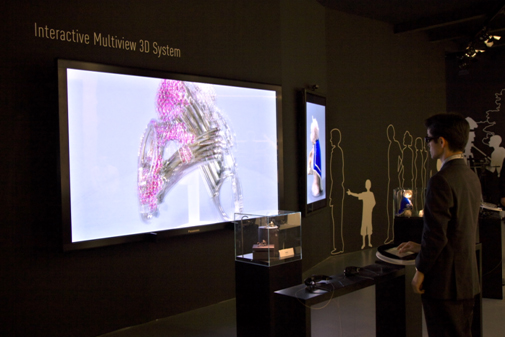Osaka, Japan - Panasonic Corporation has applied its 3D technologies to achieve an even greater sense of realism with the development of its Interactive Multi-view 3D System and the world's largest*1 glasses-free 3D plasma display. Both systems will be presented to the B2B field as new solutions for 3D businesses. Panasonic will exhibit these technologies at its corporate booth at the IFA 2012 show to be held in Berlin, Germany, from August 31.
In order to achieve ever greater levels of audiovisual quality, broadcasting and other imaging technologies have undergone a long-term process of evolution from black-and-white to color and from standard definition to high definition. Today, Panasonic is working to carry this evolution into a new plane of true-to-life, immersive communication with the development of 3D imaging and high-definition imaging technologies.
At its corporate booth, Panasonic will present its newly-developed Interactive Multi-view 3D System which allows the viewer to control the object image through a touch panel, and view the image at the size and from the angle they desire. The system is capable of accurate three-dimensional display without any sense of warping, thus realizing the full, high-quality expressive potential of 3D video. In addition, Panasonic will also exhibit its 103-inch glasses-free 3D plasma display, the largest in the world, that reproduces high-definition 3D video with very little moire interference or crosstalk compared to other such systems. It is anticipated that both of these 3D display systems will be utilized across a wide spectrum of industries.
*1 As of August 29, 2012
Outline of the New Systems
1. Interactive Multi-view 3D System
The Interactive Multi-view 3D System optimally utilizes the special characteristics of 3D to richly express the texture of the object. The user can control the image of an object taken from multiple angles through a touch panel, giving the user the freedom to view the object at the angle and size they desire in full HD 3D.
The 3D system is able to display the shape and depth of the 3D image accurately regardless of the magnification ratio and display high resolution images at high speeds. The active-shutter type display is able to accurately express the color and texture of objects.
- As an archive for art galleries and museums, or as a virtual gallery
- As a high quality catalogue for auctions or net shopping services
- As a healthcare education system which can display 3D images of the anatomy of the body.
2. World's Largest Glasses-free 3D Plasma Display
The display offers impressive 3D images on a 103-inch glasses-free plasma display, the largest in the world. It can display images at a higher resolution and a higher quality than current parallax barrier type glasses-free 3D displays.
Through the use of 4K2K plasma panels, it is possible to display high definition 3D images at a resolution equivalent to HD, and by utilizing a newly developed barrier, moire interference and crosstalk has been reduced by about half of that of previous glasses-free 3D systems.
- For 3D digital signage where the use of 3D glasses is impractical
- As a highly immersive 3D showroom for cars or interior design.
Panasonic presented the world's first home 3D theater system with a plasma television and a Blu-ray Disc player back in September 2008, before establishing the Panasonic Hollywood Laboratory Advanced Authoring Center (PHL-AC) -- a facility for the authoring of 3D Hollywood movies onto Blu-ray Disc -- in February 2009. In 2010, it led the industry in releasing a succession of 3D-compatible televisions, Blu-ray Disc players, and camera recorders to help create a whole new market for the technology. Thanks to technical support from Panasonic, this year's London 2012 Olympic Games was the first in Olympic history to be broadcast in 3D. The company continues to advance its 3D technologies and lead the industry with the proposal of new ideas and values.
Panasonic is also engaged in the development of other high-definition displays to achieve more realistic viewing experiences. This year, it is working with the Japanese state broadcaster Japan Broadcasting Corporation (NHK) to jointly develop a 145-inch plasma display panel for the next-generation ultra high-definition broadcast system, SUPER Hi-VISION*2, while the company is also developing a 20-inch 4K2K IPSα LCD panel*3, the smallest in the world*4.
*2 Pixels: Horizontal 7,680 X Vertical 4,320
*3 Pixels: Horizontal 3,840 X Vertical 2,160
*4 As of August 29, 2012
Panasonic will continue to pursue the development of higher-performance, higher-quality 3D processing technologies and high-definition displays to bring ever more realistic viewing experiences to its customers.

Demonstration of the Interactive Multiview 3D System at IFA 2012

Demonstration of the 103-inch Glassless 3D Plasma Display Panel at IFA 2012
About Panasonic
Panasonic Corporation is a worldwide leader in the development and manufacture of electronic products in three business fields, consumer, components & devices, and solutions. Based in Osaka, Japan, the company recorded consolidated net sales of 7.85 trillion yen for the year ended March 31, 2012. Panasonic's stock is listed on the Tokyo, Osaka, Nagoya and New York (NYSE:PC) Stock Exchanges. The company has the vision of becoming the No. 1 Green Innovation Company in the Electronics Industry by the 100th year of its founding in 2018. For more information on Panasonic, its brand and commitment to sustainability, visit the company's website at http://panasonic.net/.
Media Contacts:
- Global Public Relations Office
- Panasonic Corporation
- Tel: +81-(0)3-6403-3040 Fax: +81-(0)3-3436-6766
- Panasonic News Bureau
- Tel: +81-(0)3-3542-6205 Fax: +81-(0)3-3542-9018






